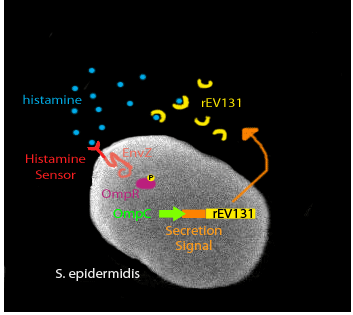Team:Brown/Project All Together
From 2009.igem.org
(Difference between revisions)
| (6 intermediate revisions not shown) | |||
| Line 6: | Line 6: | ||
| - | + | <html><img src="http://img18.imageshack.us/img18/1602/constructinaction.png"></html> | |
| - | + | [[Image:Cascade.gif|center]] | |
| + | # Mast cells release histamine during the allergic response. | ||
| + | # Histamine binds to our re-engineered histamine receptor. | ||
| + | # This receptor’s intracellular kinase domain EnvZ phosphorylates transcription factor OmpR. | ||
| + | # OmpR turns on transcription of DNA under the OmpC promoter. | ||
| + | # The genes for rEV131 with its attached secretion signal are transcribed. | ||
| + | # After translation, the signal peptide causes rEV131 to be secreted into the extracellular fluid. | ||
| + | # rEV131 sequesters histamine, preventing it from interacting with the human histamine receptors. | ||
| + | # The transcription and secretion of rEV131 continues as long as histamine is present in the extracellular fluid. When histamine concentration returns to its pre-allergic response state, production of rEV131 stops because the initiating ligand histamine is no longer present. | ||
| - | + | <html> | |
| - | + | <a href="https://2009.igem.org/Team:Brown/Project_Implications"> | |
| - | + | <img src="https://static.igem.org/mediawiki/2009/b/b2/Human_practices_brown_button.png"> | |
| - | + | </html> | |
| - | + | ||
| - | + | ||
| - | + | ||
| - | + | ||
| - | + | ||
| - | + | ||
| - | + | ||
Latest revision as of 03:33, 22 October 2009

- Mast cells release histamine during the allergic response.
- Histamine binds to our re-engineered histamine receptor.
- This receptor’s intracellular kinase domain EnvZ phosphorylates transcription factor OmpR.
- OmpR turns on transcription of DNA under the OmpC promoter.
- The genes for rEV131 with its attached secretion signal are transcribed.
- After translation, the signal peptide causes rEV131 to be secreted into the extracellular fluid.
- rEV131 sequesters histamine, preventing it from interacting with the human histamine receptors.
- The transcription and secretion of rEV131 continues as long as histamine is present in the extracellular fluid. When histamine concentration returns to its pre-allergic response state, production of rEV131 stops because the initiating ligand histamine is no longer present.
 "
"

